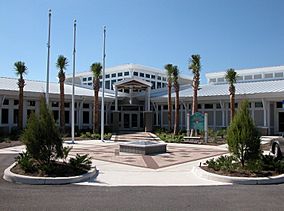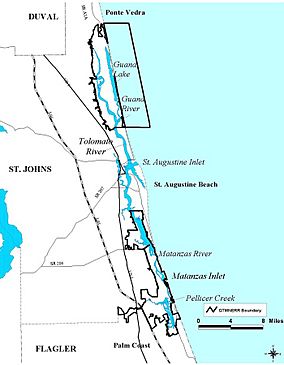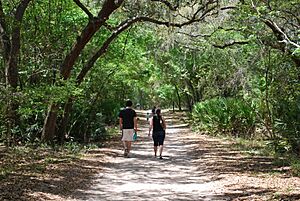Guana Tolomato Matanzas National Estuarine Research Reserve facts for kids
Quick facts for kids Guana Tolomato Matanzas National Estuarine Research Reserve |
|
|---|---|
| GTM Research Reserve | |
|
IUCN Category IV (Habitat/Species Management Area)
|
|

Environmental Education Center
|
|

Guana Tolomato Matanzas National Estuarine Research Reserve - Map
|
|
| Location | St. Johns and Flagler counties, Florida, United States |
| Nearest city | St. Augustine |
| Area | 73,256 acres (29,646 ha) |
| Established | 1999 |
| http://www.dep.state.fl.us/coastal/sites/gtm/ http://www.gtmnerr.org | |
The Guana Tolomato Matanzas National Estuarine Research Reserve (GTM Research Reserve) was created in 1999. It is located in St. Johns and Flagler counties, Florida. This special area is part of the National Oceanic and Atmospheric Administration (NOAA) National Estuarine Research Reserve (NERR) system.
The GTM Research Reserve is one of 29 NERRs across 23 states and one territory. In Florida, it is one of three such reserves. The Florida Department of Environmental Protection helps manage it. Many groups work together to protect and study the GTM Research Reserve. These include NOAA, the Florida Fish and Wildlife Commission, and several universities.
Contents
What is the GTM Research Reserve?
The GTM Research Reserve covers a huge area of 76,760 acres. It stretches along the Guana, Tolomato, and Matanzas rivers, and the Atlantic Coast. Its main goal is to protect nature and its cultural history. It uses science and education to do this. The reserve was officially opened on August 19, 1999.
This area was once known as Guana River State Park. It has many different natural habitats. You can find pine flatwoods, coastal forests (called maritime hammocks), sandy beaches, dunes, and mangroves.
The reserve is a very important place for animals. It's a key area where endangered North Atlantic right whales give birth. Many other animals live here too. These include dolphins, manatees, sea turtles, gopher tortoises, American alligators, indigo snakes, and river otters. You might also spot amazing birds like peregrine falcons, bald eagles, brown and white pelicans, wood storks, and roseate spoonbills. The endangered Anastasia Island beach mouse also calls this place home.
Exploring the GTM Research Reserve
The main GTM Research Reserve Visitor Center is at 505 Guana River Road in Ponte Vedra Beach, Florida. It's about ten miles north of St. Augustine on State Road A1A. This center is where people learn about the reserve. It's also used for research and managing the northern part of the reserve.
The southern part of the GTM Research Reserve includes several other parks and protected areas. These are places like Pellicer Creek Aquatic Preserve, Faver-Dykes State Park, and Fort Matanzas National Monument. There is also a smaller office building in Marineland.
Fun Things to Do at the Reserve
There are many fun activities you can do at the GTM Research Reserve. You can go hiking, bicycling, fishing, kayaking, and canoeing. It's also a great place for walking your dog, horseback riding, picnicking, and watching birds.
The reserve has over nine miles (14 km) of nature trails. These trails let you explore the beautiful natural setting. You can also find seventeen archaeological sites here. These include ancient shell middens and a prehistoric earthen burial mound. If you want to explore more, you can rent kayaks, bicycles, and fishing boats. North Guana Outpost offers rental and tour services right at the reserve.
How the Reserve Was Formed
Before it became a state park, this land was privately owned. People could hunt and fish there. In 1957, the Guana River was dammed. This created Guana Lake to help attract more waterfowl in winter. The lake water is a mix of fresh and saltwater (called brackish) near the dam. As you go further from the dam, it becomes freshwater. This means you can find both saltwater and freshwater fish in the same lake!
The State of Florida bought the land from Gate Petroleum in 1984. It was then split into Guana River State Park and the Guana River Wildlife Management Area. In 2004, the GTM Environmental Education Center was built. At that time, the state park lands became part of the larger GTM Research Reserve.
The Guana Tract
The Guana River State Park officially became part of the Guana Tolomato Matanzas National Estuarine Research Reserve in 2004. So, it is no longer a separate State Park. This area, known as the Guana Tract, is located along State Highway A1A. It sits between St. Augustine and Jacksonville. The Atlantic Ocean borders it on one side, and the Intracoastal Waterway (Tolomato River) on the other. The Guana Tract, which includes the GTM Research Reserve and Guana River Wildlife Management Area, covers about 12,000 acres of protected land.


